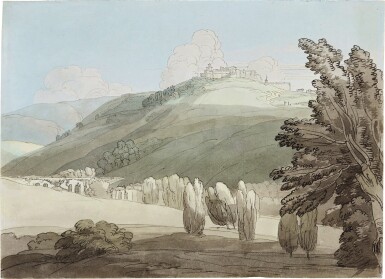A Fine Line: Master Works on Paper from Five Centuries
A Fine Line: Master Works on Paper from Five Centuries

Property from an Important English Collection
Francis Towne
Castel Madama, above the River Aniene, near Tivoli
Auction Closed
July 7, 10:53 AM GMT
Estimate
20,000 - 30,000 GBP
Lot Details
Description
Property from an Important English Collection
Francis Towne
Isleworth, Middlesex 1739 - 1816 London
Castel Madama, above the River Aniene, near Tivoli
Pen and grey ink and watercolour, on laid paper with a fragmentary watermark;
signed, dated and inscribed verso: Castello Madamo / No. 2. / April 22. 1781 / Light coming in from the right hand. / Francis Towne
235 by 324 mm
John Herman Merivale (1779-1844), Towne’s residuary legatee;
by family descent to Dorothea, Lady Bunbury, née Merivale (1888-1951);
with Agnew's, London;
by whom sold to Charles Richard Nairne Routh (1896-1976), 1946;
with Agnew's, London, by 1949;
Sir William Worsley, 4th Bt (1890-1973);
by family descent until,
sale, London, Christie's, 5 June 2003, lot 38;
where acquired by the present owner
W.A. Worsley, Early English Water-Colours at Hovingham Hall, 1963, no. 58;
R. Stephens, A Catalogue Raisonné of Francis Towne (1739-1816), online, no. FT247
Francis Towne is widely considered to be amongst the most original landscape painters of the late eighteenth century and it was in Italy, which he visited in 1780-1781, that he created his finest work.
The present drawing perfectly illustrates Towne’s unique approach, with its lovely combination of neat, crisp pen lines and his fascination with the interplay between deep shadows and the warm Italian sunlight.
The work is dated '22 April' and it is one of three surviving watercolours that he painted on that day which depict Castel Madama, a hillside town which lies beyond the falls of Tivoli, to the east of Rome.1
This drawing has a long and distinguished history. As per the terms of Towne’s will, it - along with the rest of the contents of his studio – was bequeathed first to his friend, James White, an Exeter based lawyer, and then, upon White's death, to John Herman Merivale, the son of Towne’s great friend John Merivale of Barton Place (1752-1831). The drawing then descended in the Merivale family to Dorothea, Lady Bunbury (1888-1951), wife of the prominent civil servant Sir Henry Bunbury. Later in the 20th century it belonged to the author Charles Richard Nairne Routh, and Sir William Worsley of Hovingham Hall, Yorkshire. Both these collectors owned important works by Towne.
1. Stephens, op. cit., nos. FT246 & 248
